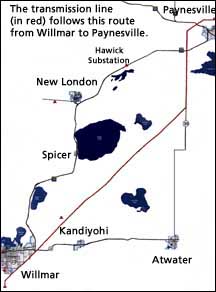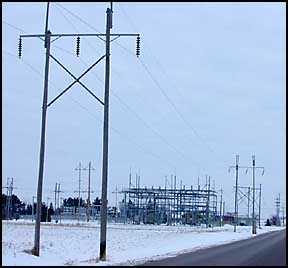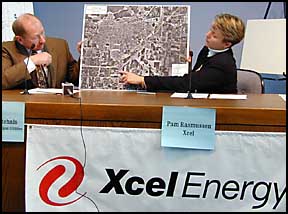 The line supplies power to the cities of Willmar, Spicer, New London, and Paynesville, and to the surrounding rural areas.
The line supplies power to the cities of Willmar, Spicer, New London, and Paynesville, and to the surrounding rural areas.The $13 million proposal by Xcel Energy to rebuild the transmission that runs from Willmar to Paynesville was unveiled last week. Construction could begin in 2003 and a new line could be completed by 2004.
Transmission lines carry power from the generating plants to substations. Power is then disbursed from the substation through distribution lines to users.
The 32-mile, double-poled transmission line runs from Willmar, south of Green Lake, to the Tri-County Road. It follows the Tri-County Road north for nearly six miles before crossing the north fork of the Crow River and reaching the Xcel Energy substation just north of Paynesville.
 The line supplies power to the cities of Willmar, Spicer, New London, and Paynesville, and to the surrounding rural areas.
The line supplies power to the cities of Willmar, Spicer, New London, and Paynesville, and to the surrounding rural areas.
The existing transmission line was built nearly 70 years ago, in 1931. It has been upgraded and maintained since then, but Xcel Energy (formerly Northern States Power) has determined that it is near the end of its useful life.
As the existing line was built when people were still driving Model T Fords, "It's becoming clear to us that (the line is) meeting the end of its useful life and we need to make some changes to provide consistent power to the area," said Pam Rasmussen, a permitting analyst for Xcel Energy.
With up to 60 percent of the 70-year-old poles prone to failure, reliability of the line is a concern.
Mike Nitchals of Willmar Municipal Utilities called the project a win-win-win-win-win situation, saying that Excel Energy, local power companies, landowners, businesses, and electric customers would benefit. "This project will go a long way to making sure that the lights don't go out," he said.
 Growth in the region and increased demand for electricity is another reason for the upgrade. "As you all probably are aware, energy demand is increasing and improved infrastructure is needed to meet increased demand," said Rasmussen.
Growth in the region and increased demand for electricity is another reason for the upgrade. "As you all probably are aware, energy demand is increasing and improved infrastructure is needed to meet increased demand," said Rasmussen.
Load growth in the area is four percent per year, said Mike Steckelberg of Great River Energy, which supplies power to both the Kandiyohi and Meeker county electric cooperatives.
The existing 115kV line will be replaced by a 230kV line that could carry four times the amount of power. Not all that capacity is needed immediately, but the project is intended to accommodate future growth in the region.
"If we build it to 230kV, we hope it will last another 70 years," said Steckelberg.
The new line would use the same route as the existing line, except for a short stretch in Willmar. The line would be moved from what is now a residential area of the city, and would follow Highway 23 instead before angling to the northeast. (See map.)
Landowners on the route have already been sent letters by Xcel Energy, which also has two field agents who will be visiting landowners in person.
The existing double-poled wood structures will be replaced by a single-pole line along the Tri-County Road (also called the Roseville Road). These should be more convenient for farmers, said Greg Schneider, a senior right-of-way agent for Xcel Energy. They could be up to 20 feet taller than the existing poles. Schneider said that landowners will be compensated for damage caused by the project.
Schneider said that landowners will be compensated for damage caused by the project.
Exact coordination will be needed to avoid power disruptions during the construction.
The project needs approval from the Minnesota Environmental Quality Board. Xcel Energy hopes to gain an exemption in 2001. Their application will be filed with the EQB and copies will be sent to landowners on the line route.
The public has 60 days to comment. Any landowner can force a public hearing about the project just by asking. Any other request for a public hearing will be considered by the EQB.
If the project gets EQB approval, Xcel Energy still would need to get local permits from the counties and townships along the route. In the Paynesville area, this includes Irving, Roseville, and Paynesville townships.
Should the exemption and local approval be granted, Rasmussen said construction could begin in 2003 and finish in 2004.
More improvements would also be needed at the Paynesville substation to accommodate the increased power load. Of the $13 million total cost, Xcel estimated the line will cost $8.5 million and $4.5 million will be spent to double the size of the Paynesville substation. Some improvements were already made to the Paynesville substation last summer.
The project will be done with funds designated for infrastructure improvements, Rasmussen said, and electric rates for customers should not be affected.